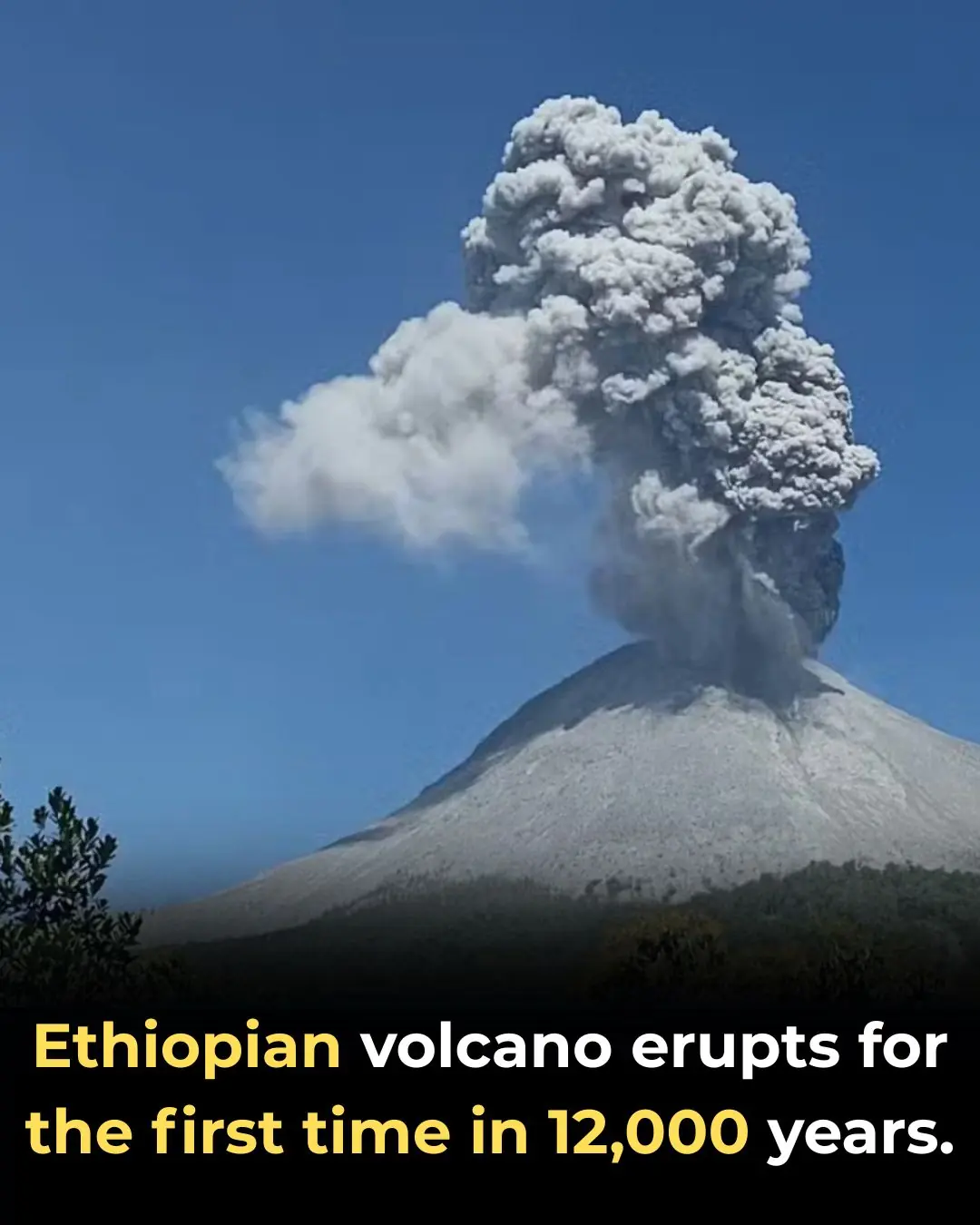
After 12 Millennia of Silence, Ethiopia’s Hayli Gubbi Volcano Erupts Dramatically
A volcano that had remained silent for roughly 12,000 years has erupted in Ethiopia’s Afar region, marking its first known activity since the early Holocene. The Hayli Gubbi volcano—situated in one of the most geologically active rift zones on Earth and lying close to the border with Eritrea—unexpectedly released a towering column of ash and sulfur dioxide that rose nearly 14 kilometers into the atmosphere. According to satellite observations from NASA’s Earth Observatory and atmospheric monitoring agencies, the ash plume drifted westward across the Red Sea, with its trajectory extending toward Yemen, Oman, India, and northern Pakistan as upper-level winds carried the fine particles across the region.
What made this event particularly striking to volcanologists is the complete absence of recorded eruptions from Hayli Gubbi throughout the entire Holocene epoch. The Smithsonian Institution’s Global Volcanism Program notes that many volcanoes in the Afar Depression show intermittent activity, but Hayli Gubbi had long been considered dormant based on all available geological and eruptive history records. Its abrupt reactivation has therefore raised questions about deeper magmatic processes occurring beneath the East African Rift System, where tectonic plates are slowly pulling apart.
Local reports from communities in the Danakil Depression—one of the hottest and most sparsely populated regions on Earth—described heavy ashfall blanketing grazing areas and contaminating scarce water sources. Residents expressed concern about the potential impact on livestock, which form the backbone of the local pastoral economy. While authorities confirmed that there were no immediate casualties, emergency teams have begun evaluating possible long-term threats to food security, groundwater quality, and respiratory health. The United Nations Office for the Coordination of Humanitarian Affairs (OCHA) has indicated that additional monitoring and support may be needed if ashfall continues or if new eruptive phases arise.
Aviation authorities in Ethiopia and neighboring countries issued alerts shortly after the plume was detected. Several regional flight routes across northern Ethiopia, Djibouti, and Eritrea were temporarily adjusted in accordance with International Civil Aviation Organization (ICAO) guidelines, since volcanic ash poses a severe hazard to aircraft engines and navigation systems. The USGS Volcano Hazards Program emphasizes that high-altitude ash clouds can travel thousands of kilometers and remain dangerous long after an eruption begins.
Scientists are now conducting rapid-response assessments to determine whether this eruption represents a brief, isolated burst of activity or signals a longer-term shift in volcanic behavior within the Afar Rift. Geophysical teams are analyzing seismic data, ground deformation patterns, and gas emissions to understand the scale of the underlying magma movement. Researchers from regional universities and international institutions have emphasized that this rare event offers an important opportunity to study an under-documented volcano in one of the world’s most dynamic tectonic landscapes.
Although many uncertainties remain, experts agree that the sudden awakening of Hayli Gubbi highlights the evolving geological hazards of the East African Rift and underscores the importance of continuous monitoring in remote, understudied volcanic systems.
Sources:
– Smithsonian Institution, Global Volcanism Program
– NASA Earth Observatory
– USGS Volcano Hazards Program
– United Nations OCHA
News in the same category


Hayli Gubbi Volcano Erupts in Ethiopia for First Time in 12,000 Years

Mia Khalifa at Oxford: A Controversial Talk on Redemption, Reinvention, and Second Chances

Breaking Bob: How a 75-Year-Old Turned a Five-Minute Smoke Break into a Viral NYC Spectacle

The Night Google.com Was Accidentally Sold for $12: A Story of Integrity and Goodwill

When a Woman Bites Her Lip While Staring at You, It Means She Is ...

How Europe Says "Street": A Multilingual Journey Through Language and Culture

A New Dawn for Chronic Kidney Disease Treatment: From Management to Possible Remission

A Butterfly, A Flute, and Unshakable Composure: The Legendary Performance of Yukie Ota

Felix Baumgartner's Record-Breaking Jump: Breaking the Sound Barrier from Space

A Pacemaker the Size of a Grain of Rice: Revolutionizing Heart Care

Denmark’s Ground‑Breaking Proposal: Granting Citizens Copyright Over Their Face, Voice and Body to Combat Deepfakes

Science vs. Disney: What Finding Nemo Didn’t Tell You About Clownfish

U.S. Grocery Costs Hit Record High: Families Now Spending Over $1,000 a Month

When Mating Turns Dangerous: The Fierce Behavior of the Sydney Octopus

Welcome to the Monkey Madness: Thailand’s Unforgettable Lopburi Buffet

Why Height Matters So Much in Online Dating — And What the Numbers Reveal

Samsung Outpaces Apple Again — And Why Shipment Volume Still Matters

Thicker Thighs Linked to Lower Risk of Heart Disease and Diabetes, Study Finds
News Post

Vietnam Approves Russian-Made Cancer Immunotherapy ‘Pembroria’ for Multiple Cancer Types

The Kid Who Was Surprised By Dad With Birthday Bat In Viral Video Hits Home Run With Bat And Dad Catches It

Delaware Post Office Renamed In Honor of Mary Ann Shadd Cary, First Black Woman Publisher

Hayli Gubbi Volcano Erupts in Ethiopia for First Time in 12,000 Years

Meet Shantrelle P. Lewis, Curator, Filmmaker & the Preeminent Scholar of Global Black Dandyism

Jalen McKee-Rodriguez Makes History As First Openly Gay Black Man To Be Elected To Office In Texas

Mia Khalifa at Oxford: A Controversial Talk on Redemption, Reinvention, and Second Chances

Breaking Bob: How a 75-Year-Old Turned a Five-Minute Smoke Break into a Viral NYC Spectacle

The Night Google.com Was Accidentally Sold for $12: A Story of Integrity and Goodwill

6 fruits that help your body fight cancer cells naturally

17 signs of kidney trouble you can see—don’t ignore #3!

When a Woman Bites Her Lip While Staring at You, It Means She Is ...

Have you noticed small white spots on your arms or legs… and you don't know what they are?

4 Best Clove Toners for Beautiful Skin

How Europe Says "Street": A Multilingual Journey Through Language and Culture

Never Toss Banana Peels Again: The 2,000-Year-Old “Trash” Trick That Erases Wrinkles, Heals Scars, Whitens Teeth & Drops Blood Pressure Overnight

A New Dawn for Chronic Kidney Disease Treatment: From Management to Possible Remission

A Butterfly, A Flute, and Unshakable Composure: The Legendary Performance of Yukie Ota
